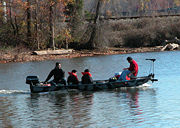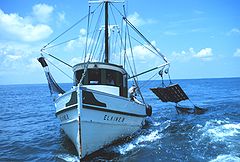Recreational fishing
|
|||||
Recreational fishing, also called sport fishing, is fishing for pleasure or competition. It can be contrasted with commercial fishing, which is fishing for profit, or subsidence fishing, which is fishing for survival.
The most common form of recreational fishing is done with a rod, reel, line, hooks and any one of a wide range of baits. Other devices, commonly referred to as terminal tackle, are also used to affect or complement the presentation of the bait to the targeted fish. Some examples of terminal tackle include weights, floats, and swivels. Lures are frequently used in place of bait. Some hobbyists make handmade tackle themselves, including plastic lures and artificial flies. The practice of catching or attempting to catch fish with a hook is known as angling.
Sport fishing was previously dominated by men, however more women are participating in this sport.
When angling, it is sometimes expected or required that the fish be returned to the water (catch and release).
One method of growing popularity is kayak fishing. Kayak fisherman fish from sea kayaks in an attempt to level the playing field with fish and to further challenge their abilities. Kayaks are extremely stealthy and can allow anglers to reach areas unfishable from land or by conventional boat.[1]
Big-game fishing is fishing from boats to catch large open-water species such as tuna, sharks and marlin. Noodling and trout tickling are also recreational activities.
Contents |
History
The earliest English essay on recreational fishing was published in 1496, shortly after the invention of the printing press. The authorship of this was attributed to Dame Juliana Berners, the prioress of the Benedictine Sopwell Nunnery. The essay was titled Treatyse of Fysshynge wyth an Angle, and was published in the second Boke of St Albans, a treatise on hawking, hunting and heraldry. These were major interests of the nobility, and the publisher, Wynkyn de Worde, was concerned that the book should be kept from those who were not gentlemen, since their immoderation in angling might "utterly destroye it".[2]
During the 16th century the work was much read, and was reprinted many times. Treatyse includes detailed information on fishing waters, the construction of rods and lines, and the use of natural baits and artificial flies. It also includes modern concerns about conservation and angler etiquette.[3]
Recreational fishing for sport or leisure took off during the 16th and 17th centuries, and coincides with the publication of Izaak Walton's The Compleat Angler, or Contemplative Man's Recreation in 1653. This book is the definitive work that champions the position of the angler who loves fishing for the sake of fishing.[2]
More than 300 editions of The Compleat Angler have been published, which makes it one of the most frequently reprinted books in English literature. The pastoral discourse is enriched with country fishing folklore, songs and poems, recipes and anecdotes, moral meditations and quotes from classic literature. The central character, Piscator, champions the art of angling, but also tranquilly relishes the pleasures of friendship, verse and song, good food and drink.[4]
Big-game fishing started as a sport after the invention of the motorized boat. In 1898, Dr. Charles Frederick Holder, a marine biologist and early conservationist, virtually invented this sport and went on to publish many articles and books on the subject noted for their combination of accurate scientific detail with exciting narratives.
Sport fishing

Sport fishing methods vary according to the area being fished, the species being targeted, the personal strategies of the angler, and the resources available, ranging from the aristocratic art of fly fishing, ostensibly invented in Great Britain,[5] to the high-tech methods used to chase marlin and tuna. In virtually every case, however, the fishing is done with hook, line, rod and reel rather than with nets or other aids.
The most common salt water game fish sought after are marlin, tuna, tarpon, sailfish, shark, and mackerel.[6]
In the past, sport fishers, even if they did not eat their catch, almost always killed them to bring them to shore to be weighed or for preservation as trophies. A desire to improve the fishery[7] has prompted many sport fishermen to catch and release, sometimes after fitting them with identity tags, recording some vital statistics, and mailing in a record to a government agency in something called tag and release.
Sport fishing competitions involve individuals if the fishing occurs from land, and usually teams if conducted from boats, as well as a specified time and area from which to catch fish. A score is awarded for each fish caught. The points awarded depend on the fish's weight and species. Occasionally a score is divided by the strength of the fishing line used, yielding more points to those who use thinner, weaker line. In tag and release competitions, a flat score is awarded per fish species caught, divided by the line strength. Usually sport fishing competitions award a prize to the boat or team with the most points earned.[8]
Fish logs
In addition to capturing fish for food, recreational anglers also enjoy keeping a log of fish caught and submitting trophy-sized fish to independent record keeping bodies. In the Republic of Ireland the Irish Specimen Fish Committee verify and publicize the capture of specimen (i.e. trophy) fish caught on rod and line by anglers in Ireland, both in freshwater and at sea. The Committee also ratifies Irish record rod caught fish. It also uses a set of 'fair play' regulations to ensure fish are caught in accordance with accepted angling norms.[9]
Competitions
A recent phenomenon of recreational fishing is fishing competitions (tournaments) where fishermen compete for prizes based on the total weight of a given species of fish caught within a predetermined time. This sport evolved from local fishing contests into large competitive circuits, especially in North America. Competitors are most often professional fishermen who are supported by commercial endorsements. Other competitions are based purely on length with mandatory catch and release. Either longest fish or total length is documented with a camera and a mandatory sticker, a practice used since it's hard to weigh a living fish accurately in a boat.
Rules and regulations
Recreational fishing has conventions, rules, licensing restrictions and laws that limit the way in which fish may be caught. The International Game Fish Association (IGFA) makes and oversees a set of voluntary obligations. Typically, these prohibit the use of nets and the catching of fish with hooks not in the mouth. Enforceable regulations are put in place by Governments to ensure sustainable practice amongst anglers. For example in the Republic of Ireland, the Central Fisheries Board oversees the implementation of all angling regulations, which include controls on angling lures, baits and number of hooks permissible, as well as licensing regimes and other conservation based restrictions.[10]
Industry
The recreational fishing industry consists of enterprises such as the manufacture and retailing of fishing tackle, the design and building of recreational fishing boats, and the provision of fishing boats for charter and guided fishing adventures.
"Pay to fish" enterprises provide anglers with controlled access to stocked lakes, ponds or canals. These provide fishing opportunities outside of the permitted seasons and quotas applied to public waters. In the United Kingdom, commercial fisheries of this sort charge access fees. In North America, establishments usually charge for the fish caught, by length or by weight, rather than for access to the site although some establishments charge both types of fees.
In the USA alone, 12 million recreational saltwater fishers generate $30 billion in economic impact and support 350,000 jobs.[11]
See also
- Angling
- ANSA
- Bass fishing
- Big-game fishing
- Coarse fishing
- Fishing lures
- Fly fishing
- Ice fishing
- IGFA
- Rock fishing
- Troll (angling)
- Fishing Derby (event)
- Environmental effects of fishing
Notes
- ↑ Null, Scott and Mcbride, Joel (2007) Kayak Fishing: The Ultimate Guide.Heliconia Press. ISBN 978-1896980287
- ↑ 2.0 2.1 Cowx, I G (2002) Handbook of Fish Biology and Fisheries, Chapter 17: Recreational fishing. Blackwell Publishing. ISBN 063206482X
- ↑ Berners, Dame Juliana. (2008). In Encyclopædia Britannica. Retrieved June 20, 2008, from Encyclopædia Britannica Online
- ↑ Walton, Izaak. (2008). In Encyclopædia Britannica. Retrieved June 20, 2008, from Encyclopædia Britannica Online
- ↑ A fly fishing history
- ↑ Dunn, Bob (2000) Saltwater Game Fishes of the World. Australian Fishing Network.ISBN 978-1865130101
- ↑ Catch And Release Fishing
- ↑ Sportfishing in America - American Sportfishing Association
- ↑ ISFC Trophy Fish Website Irish Specimen Fish Committee
- ↑ Fishing in Ireland Central Fisheries Board Website
- ↑ NOAA Fisheries: Recreational Fishing Services.
References
- Baron, Frank P (2003) What Fish Don't Want You to Know: An Insider's Guide to Freshwater Fishing. International Marine/Ragged Mountain Press. ISBN 978-0071417143
- Cookea, Steven J and Cowx, Ian G (2006) Contrasting recreational and commercial fishing Biological Conservation, vol 128, issue 1, p.93-108.
- Mason, Paul (2007) Fishing (Recreational Sports). Macmillan Education Australia Pty Ltd . ISBN 978-1420205831
- Pitcher, Tony J and Hollingworth, Chuck (editors) (2002)Recreation Fisheries: Ecological, Economic, and Social Evaluations. Wiley-Blackwell. ISBN 978-0632063918
- Schultz, Ken (2004) Ken Schultz's Field Guide to Saltwater Fish John Wiley and Sons. ISBN 9780471449959
External links
- University of Washington Freshwater and Marine Image Bank Images of Sport Fishing
- Recreational Fishing Laws
- Fishing advice on how to fish & where to fish
- Sport fishing at the Open Directory Project
- Fishing Forum
- SeaWeb (2004) Study In Science Reveals Recreational Fishing Takes Big Bite Of Ocean Catch. ScienceDaily. Retrieved 30 April 2008.
- Costa Rica And The World Discover it
|
|||||||||||||||||||||||||||||
